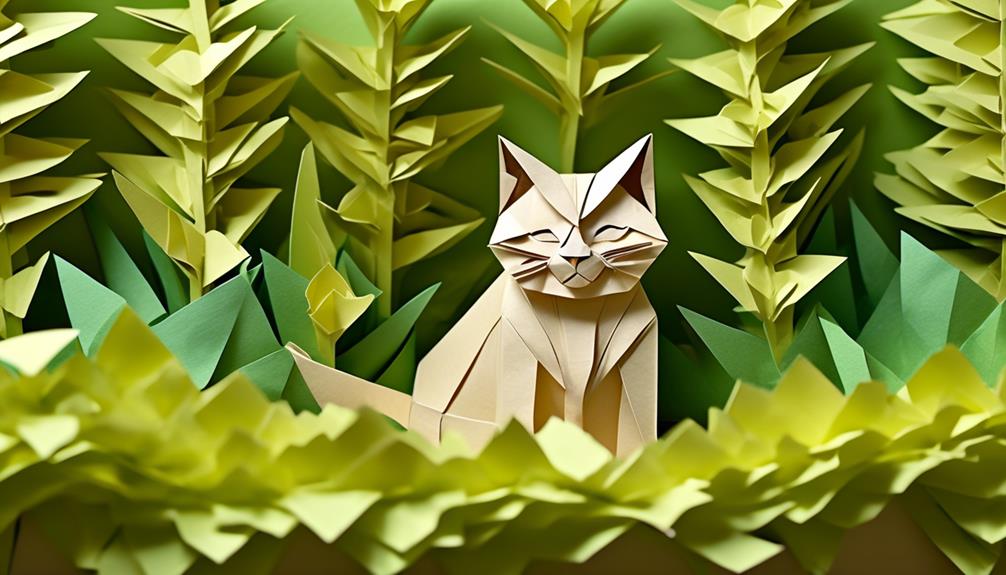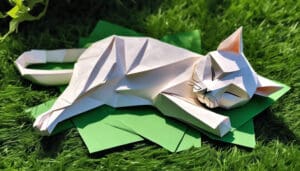Your cat, who used to jump gracefully, now hesitates before jumping onto the couch. This indicates that your cat is aging and possibly has joint issues.
Many cat owners notice their pets becoming less mobile with age. To help, offer a diet rich in nutrients, encourage light, consistent exercise, and consider natural joint-support supplements to enhance your cat’s life quality.
What’s more, understanding the subtle nuances of cat behavior can help you detect discomfort early and take action. To help your companion comfortably enjoy their later years, it’s important to consider several factors to make this period as fulfilling as possible.
Key Takeaways
- Regular exercise is crucial for maintaining joint flexibility and bone strength in aging cats.
- Optimizing your cat’s diet with high-quality cat food, fatty acids, and dietary supplements can support joint health.
- Weight management plays a significant role in reducing joint stress and alleviating symptoms of arthritis.
- Additional natural joint care strategies such as massage therapy, herbal supplements, acupuncture, and hydrotherapy can improve mobility and enhance the overall quality of life for aging cats.
Recognizing Joint Pain Symptoms
As your cat gets older, you might see small changes in how it acts, which can mean it’s in pain from joint issues. For example, it might not want to jump or go up stairs as much. It’s sad to watch your cat, which used to be very playful, become more careful in its movements. When you notice these symptoms, it’s essential to approach the situation with a blend of empathy and attention to detail.
Behavioral changes, such as a decrease in grooming, may also signal discomfort. Your cat may be experiencing aches that weren’t there before, and it’s your role to observe these shifts with a nurturing eye. They might seek out lower perches or avoid their favorite high spots altogether. It’s these small cues that can alert you to their need for support.
Importance of Regular Exercise
Maintaining your aging cat’s health demands regular exercise, a key element in preserving their joint flexibility and bone strength. As you watch your beloved cat explore the aging process, remember that exercise is important not just for their physical well-being but also for their mental sharpness. Keeping your cat engaged with multiple play sessions throughout the day can significantly improve their mobility and enrich their golden years.
Creating a home environment that challenges your cat physically, with shelving and cat trees, encourages them to leap, climb, and stay active. This isn’t just about play; it’s about offering love through the careful crafting of their living space. A proactive approach to joint care also means helping your cat maintain a healthy weight. Regular exercise, combined with portion control, mitigates the risk of obesity, which can put unnecessary strain on their aging joints.
Your dedication to regular physical activity helps keep your cat’s brain engaged, fends off weight gain, and supports overall health. By thoughtfully incorporating these strategies into your cat’s routine, you’ll be providing them with a foundation for a more comfortable and joyful life as they grow older.
Optimizing Your Cat’s Diet
To ensure your aging cat’s joints remain supple and strong, it’s vital to provide a diet rich in essential nutrients that specifically promote joint health and mobility. As you lovingly care for your cat, consider the purity of the cat food you offer. Every meal is an opportunity to nourish their body and support their well-being.
Here’s how you can optimize your cat’s diet:
Start with a high-quality cat food that includes:
- Proteins: Look for easily digestible sources that are kind to senior stomachs.
- Fatty acids: Omega-3 fatty acids are beneficial for reducing inflammation.
Incorporate dietary supplements to provide extra support:
- Glucosamine and Chondroitin: These aid in maintaining cartilage and joint fluid.
- Amino acids: Essential for muscle maintenance and overall health.
Always consult your veterinarian before adding supplements to your cat’s diet, ensuring they’re tailored to your cat’s unique needs. Remember that a healthy weight is integral to joint care; excess pounds can strain those delicate joints. Steer clear from human food scraps and low-quality processed cat food that may contain inappropriate proteins, which can do more harm than good. Your commitment to their dietary care can make a world of difference in their golden years.
Benefits of Weight Management
Managing your cat’s weight with meticulous care can significantly lessen the burden on their aging joints, enhancing their comfort and mobility. It’s heartwarming to see your cat leap and play without the shadow of discomfort. By embracing weight management, you’re providing them with a loving gift that continues to give throughout their golden years.
Reducing your pet’s weight can alleviate pain associated with arthritis—a common ailment in older cats. A lighter frame means less stress on their joints, potentially preserving those precious moments of agility and grace. Be detailed in your approach; monitor their food intake and ensure regular exercise. It’s an act of kindness that speaks volumes about your devotion.
Here’s a table that outlines the key benefits of maintaining a healthy weight in your aging cat:
| Benefit | Description |
|---|---|
| Joint Stress Reduction | Less weight translates to reduced pressure on joints. |
| Arthritis Symptom Alleviation | A healthier weight can ease the symptoms of arthritis. |
| Prevention of Joint Issues | Weight management is proactive care for joint health. |
| Enhanced Mobility | A lighter cat enjoys better movement and quality of life. |
Massage Therapy Techniques
As your cat ages, you’ll notice that they mightn’t be as spry as they once were, and that’s where massage therapy can truly make a difference.
Learning to identify the areas where your cat holds tension is the first step in providing the relief they need.
Gentle massage practices, when applied regularly, can soothe your cat’s aches, promoting a happier, more comfortable life.
Identifying Tension Areas
When your cat’s comfort is at stake, attentively observing their body language can reveal the hidden tension spots begging for your gentle touch. Dedicating time to assess their muscle tension can profoundly impact their overall joint health for aging cats prone to joint issues.
- Use gentle pressure and slow strokes
- Focus on areas prone to wear and tear
- Avoid spots where your cat flinches or tenses
Look for stiffness and decreased range of motion. Observe localized tenderness in specific muscle groups. Pay attention to subtle signs of discomfort.
Gentle Massage Practices
Having identified your cat’s areas of tension, gentle massage practices can further soothe their aching joints and enhance their well-being. As you cradle them in the calm of your touch, initiate with light, slow strokes, creating a sanctuary of comfort. With each tender motion, you’re not just easing stiffness; you’re fortifying joint health and mobility.
Delicately knead the muscles encircling their joints in circular caresses. This not only nurtures the muscle mass that supports older cats but also promotes circulation, essential for healing. Observe their responses—purring is a sign you’re on the right path.
Adjusting your technique to their comfort, integrate this nurturing ritual into your daily routine. Your caring hands become a haven, offering relief and encouraging movement with every compassionate touch.
Herbal Supplements for Joints
As your cat ages, you might find yourself searching for gentle ways to ease their joint discomfort. Herbal supplements, backed by studies on their efficacy, can offer a layer of support for your cat’s mobility.
However, it’s crucial to approach these options with safety in mind, always consulting your vet to ensure what you’re giving is both beneficial and harmless for your cherished cat.
Herbal Efficacy Studies
Recent studies into herbal supplements have offered hope to pet owners seeking natural ways to support their aging cats’ joint health. These studies have illuminated:
Herbal Supplements
- Glucosamine and chondroitin are known for reducing joint inflammation, offering your beloved cat relief from the discomfort of arthritis.
- Fatty acids, such as those found in fish oil, possess anti-inflammatory properties that can be integral in managing health issues related to your cat’s joints.
Before administering any supplements, it’s vital to consult with your vet. They can guide you on:
Safe Use
- The appropriate dosage to avoid potential side effects.
- Combining herbal supplements with NSAIDs or special diets for a holistic approach.
Supplement Safety Considerations
While herbal supplements like glucosamine and chondroitin show promise for your aging cat’s joint health, it’s crucial to prioritize safety and discuss any potential risks with your vet. You want the best for your Senior Cat, and that means making informed decisions about joint health supplements.
Be sure to talk to your vet about any herbal remedies you’re considering. They can provide guidance on supplement safety considerations, helping you to understand possible side effects and interactions.
It’s vital to monitor your cat for any adverse reactions after administering these supplements. Always store them properly and follow the recommended dosage.
Your cat relies on you to make choices that enhance their well-being, so always proceed with care and a watchful eye.
Acupuncture for feline Arthritis
If your aging cat’s agility has been hampered by the aches of arthritis, acupuncture might offer a gentle reprieve, harnessing the body’s own healing mechanisms to ease their discomfort and improve mobility. As cats age, their need for joint support becomes increasingly vital, and feline arthritis can significantly diminish their quality of life. But there’s hope in the age-old practice of acupuncture.
Acupuncture for feline arthritis:
- Reduces pain and inflammation
- Stimulates natural pain-relieving pathways
- Improves joint mobility
- Increases flexibility
- Enhances the ability to perform daily activities with ease
- Enhances overall quality of life
- Lessens the need for medication
- Promotes a sense of well-being
Seeking a qualified veterinary acupuncturist is crucial—they’ll understand the delicate nature of your cat’s condition and how best to address it. They’ll place thin needles with precision, targeting specific points to trigger your cat’s natural healing response.
Hydrotherapy for Improved Mobility
Hydrotherapy provides a beneficial, low-impact exercise for older cats, helping to strengthen their muscles and alleviate joint pain. This leads to better mobility and overall well-being. The process involves using water to gently support the cat’s body, which can reduce inflammation and improve joint health.
As your older cat paddles or walks on an underwater treadmill, you’re not just witnessing them exercise; you’re seeing their pain ease and their flexibility bloom. It’s a heartwarming scene, watching them regain a spring in their step, a testament to your dedication to their well-being.
Offering regular hydrotherapy sessions can become a cornerstone in maintaining your beloved cat’s quality of life. But it’s not a one-size-fits-all solution. It’s vital to consult with a professional who can tailor the hydrotherapy approach to your cat’s unique needs, ensuring each session is as effective as it’s safe.
You need to help and watch over your cat as they go through this process that will help them move better. They need your care to get through this and improve. You and your cat will enjoy every little success and every step that makes their life easier and more fun.
Chondroitin and Glucosamine Use
You’re seeking ways to ease your aging cat’s joint pain, and turning to glucosamine and chondroitin might be a heartfelt step towards comfort.
It’s crucial to get the dosage right, so you’ll want to talk to your vet about tailoring these supplements to meet your cat’s specific needs.
Watch closely as these supplements can offer your cat relief, but be vigilant for any side effects that may arise.
Supplement Benefits
In the golden years of their lives, aging cats can experience renewed comfort and mobility through the benefits of chondroitin and glucosamine supplements. These supplements serve as a caring embrace for their weary joints, providing a soothing touch to their daily lives.
Chondroitin and Glucosamine Supplements:
- Reduce Inflammation: They help calm the fires of joint inflammation, allowing older cats to move with less discomfort.
- Support Joint Health: By maintaining the integrity of cartilage, these supplements ensure that your cat’s joints stay supple and functional.
You’ll see a heartwarming change in your cat as these supplements bolster their immune system and ease the aches of degenerative joint diseases. Always remember, consulting with a veterinarian ensures that you’re meeting your cat’s needs responsibly and lovingly.
Dosage and Administration
Understanding the proper dosage and administration of chondroitin and glucosamine is crucial to ensure your beloved cat reaps all the joint-nurturing benefits these supplements offer. Tailoring the amount to your cat’s weight, you’ll find administering these twice daily becomes a seamless part of your routine. Support your cat’s joint health with the provided chart—it’s your trusty guide for precise dosing.
You can mix the supplements into their food or opt for direct oral application to maximize absorption.
Patience is key, as older cats may take 2-4 weeks to show improvement in their cat joint flexibility and comfort. Remember to store these herbal helpers in the fridge once opened, safeguarding their effectiveness.
Environmental Modifications at Home
Creating a safe and comfortable home environment plays a crucial role in caring for your aging cat, ensuring their golden years are filled with ease and contentment. As your cat’s joints may not be as nimble as they once were, consider these thoughtful environmental modifications at home:
Stability is Key
- Place rubber-backed runners around the house to prevent slipping.
- Put non-slip treads on stairs to make it safer for your cat to use them.
Accessibility Matters
- Elevate food and water bowls to ease the strain on your cat’s joints.
- Keep litter boxes on the floor for effortless access.
Ensuring your older cats have cozy spots to rest is vital. Provide multiple comfortable areas, and consider adding heated mats or beds for that extra touch of warmth they often crave. This not only soothes their aging bodies but also shows them how much you cherish their presence.
Frequently Asked Questions
What Is a Natural Supplement for Cats Joints?
You’re seeking a natural supplement for your beloved cat’s joints—glucosamine and chondroitin are excellent choices that can help maintain their mobility and comfort as they grow older.
How Can I Help My Senior Cat With Arthritis?
To turn your senior cat’s world into a cozy haven, make sure they’ve got easy access to food, water, and a comfy spot to snooze. Gentle brushing and soft bedding can work wonders.
Do Older Cats Need Joint Supplements?
You’re thoughtful to consider your cat’s needs. Older cats often benefit from joint supplements like glucosamine, but it’s best to consult your vet to tailor a plan suited for your cat.
How Can I Improve My Cats Joints?
To improve your cat’s joints, ensure they’re getting proper nutrition, maintain a healthy weight, and provide gentle exercise. Regular vet visits are crucial, and they may recommend joint supplements or specific treatments.




